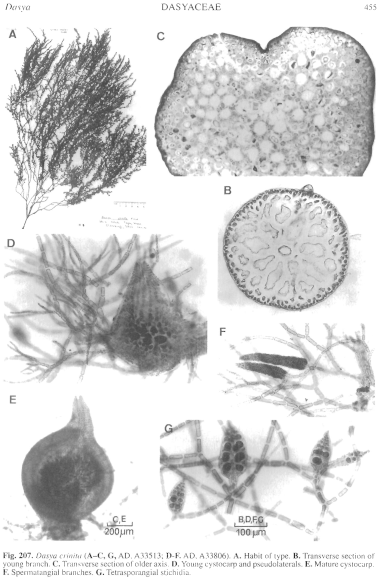|
|
|
|
|
|||||||||||
|
Electronic Flora of South Australia Species Fact Sheet
Phylum Rhodophyta – Order Ceramiales – Family Dasyaceae
Thallus (Fig. 207A) red brown, slightly mucilaginous, 25–40 cm high, with 1–2 pale, heavily corticated axes 1–2 mm in diameter, irregularly branched. Main axes irregularly subdichotomous, not percurrent, bare below, branched at intervals of 1–4 cm above with very short laterals and tufts of basally subdichotomous pseudolaterals. Main laterals 200–400 µm in diameter, 1–20 cm long, arising from the first to fifth branch of the pseudolateral (with basipetal cortication of the lower pseudolateral cells then occurring) or adventitiously from the basal cell of the pseudolateral or adjacent cortical cells. Holdfast discoid, 1–3 mm across; probably epilithic. Structure. Pericentral cells 5, heavily corticated by slender rhizoids, at first clear in section (Fig. 207B) but later obscure (Fig. 207C) as rhizoids separate them from each other; cortication commences from short cells cut off basally from pericentral cells which recover their full length as the short cell is pushed outwards and develops into a rhizoid of relatively short cells, producing a small-celled outer surface. Basipetal cortication of lower cells of the pseudolaterals is also characteristic though rather variable. Pseudolaterals one per segment, relatively firm (not lax), 1–3 mm long, below subdichotomous every (1–) 2–4 (–10) cells with 3–8 subdichotomies giving 30–40 ultimate branches many cells long, basal cells 25–35 µm in diameter and L/D 1–2, gradually attenuate above; basal segments often slightly corticate with rhizoids. Adventitious monosiphonous filaments rarely present, arising from cortical cells at base of pseudolaterals. Rhodoplasts discoid.
Reproduction: Gametophytes monoecious(?). Procarps borne spirally on a polysiphonous axis; with the first group of sterile cells dividing twice after fertilisation to produce 3 cells rather than the two usually produced in other species; carposporophytes with slight basal fusion cell and gonimoblast filament with apical and lateral clusters of 2–3 carposporangia, maturing terminally, clavate, 15–22 µm in diameter. Cystocarps terminal on corticated laterals, ovoid to globose, urceolate, 420–800 µm in diameter with a neck 0.3–0.7 as long as the cystocarp diameter; pericarp 4–5 cells thick, outer cells isodiametric to ovoid, 6–10 µm across, irregular in position. Spermatangial branches as the lower branches of the pseudolaterals, lanceoid to cylindrical, 170–250 µm long and 35–40 µm in diameter with 10–20 fertile segments, sessile or on a short monosiphonous stalk and with a 2–6 celled attenuate apical filament; 3 spermatangial branches were found on one abundantly procarpic-cystocarpic plant.
Stichidia on the lower branches of the pseudolaterals, sessile or on a 1–2-celled monosiphonous stalk which often develops basipetal rhizoidal cortication back to the parent lateral, lanceoid to cylindrical and sometimes branched or with simple or branched apical filaments, 130–250 µm long and 65–90 µm in diameter, with 5–10 fertile segments each with 4 pericentral cells all becoming fertile. Tetrasporangia 30–40 µm in diameter, each with 3 cover cells, the outer two (occasionally the central one as well) cutting off further small cells upwards and downwards so that the mature sporangia become surrounded by and partly covered by a ring of small cells.
Type from Tapley Shoal, Gulf St Vincent, S. Aust., 15 m deep outside shoal (Shepherd, 2.ii.1969); holotype in AD, A33513, tetrasporangial, isotype in CHR, 315398.
Distribution: Known from Eyre, W. Aust., Tapley Shoal and Vivonne Bay, Kangaroo I., S. Australia.
Taxonomic notes: Dasya crinita is characterised by rapidly and heavily corticated axes which are often pale in colour in contrast to the very short laterals (1–2 mm long), covered with red tufts of pseudolaterals. The specific name crinita refers to these prominent tufts.
References: The Marine Benthic Flora of Southern Australia Part IIIC
Publication:
Womersley, H.B.S. (24 December, 1998)
The Marine Benthic Flora of Southern Australia
Rhodophyta. Part IIIC. Ceramiales – Ceramiaceae, Dasyaceae
©State Herbarium of South Australia, Government of South Australia
Illustration in Womersley Part IIIA, 1998: FIG. 207.

Figure 207 enlarge
Fig. 207. Dasya crinita (A–C, G, AD, A33513; D–F, AD, A33806). A. Habit of type. B. Transverse section of young branch. C. Transverse section of older axis. D. Young cystocarp and pseudolaterals. E. Mature cystocarp. F. Spermatangial branches. G. Tetrasporangial stichidia.

|
Email Contact: State Herbarium of South Australia |

|